
Commodore 64 Hardware Photos
(last updated 2023-08-04)
 |
Commodore 64 Hardware Photos(last updated 2023-08-04) |
 |
|
JiffyDOS | This is where I keep photos and documentation for some of the more exotic Commodore 64 hardware in my collection; most of the images can be clicked on for a larger view. Some of it I bought back in the day; some (like the CARDBOARD/5 and third-party drives) are more recent acquisitions. I also have a separate page devoted to the stereo SID modification. If you have questions, you can email me (cenbe at protonmail dot com). |
JiffyDOSJiffyDOS is not exotic hardware; most Commodore users consider it essential. It is an alternate communication protocol for Commodore floppy drives that can speed up disk access by a factor of ten or more. One replacement ROM is installed in the Commodore 64 itself, while another ROM is installed in each disk drive. The CMD devices (FD series 3 1/2" floppies, HD series hard drives, and even the RAMLink) all had JiffyDOS built in, and most Commodore users consider it de rigueur. The saga of JiffyDOS is a strange one. It was once manufactured by the legendary Creative Micro Designs (CMD); here's a video of Craig Ernster visiting their headquarters in 1999. Its sale was later licensed to a company whose repeated failure to fulfill orders earned its dishonor in the Commodore community, and made its owner persona non grata. Naturally, the result was that JiffyDOS became available by... shall we say, other means. In May 2009, Jim Brain announced (by projecting the information onto a wall from a Commodore SX-64 at C=4 2009) that he had entered into an agreement with Mark Fellows (formerly of CMD) to become the second licensee of JiffyDOS (and possibly other of their products). In October 2009, JiffyDOS became available in an online store on Jim's site.
Here we see two photos of JiffyDOS installed in a 1541-II 5 1/4" floppy disk drive. The beauty of JiffyDOS is that you can go back to the original ROMs with the flick of a switch (although it's rarely necessary because of the high degree of backward compatibility). The second picture shows this in detail: the wires lead to a toggle switch (shipped with the ROMs), which is normally installed by drilling a small hole in the back of the case. |
Here is some more information on CMD products:
I've got a primer that shows the syntax of some of the less often used JiffyDOS and CMD HD/FD commands.
The JiffyDOS manual is available on Jim Brain's site.
an article (PDF format) on the timing details of the SuperCPU and SuperRAM, excerpted from Commodore World magazine, issue 19.
a Q-Link post from 1992 that gives some insight into CMD's attitude toward copyrights. Note where they say "I have stated before that JiffyDOS COULD be faster, but we have avoided implementing it as such to maintain good hardware and software compatibility".
the 2001 notice from CMD that they were exiting the Commodore business
The RAMBOard was sold by Software Support International, and was used in conjunction with special software to achieve full-track GCR disk copies on a Commodore 5 1/4" floppy drive. It added 8K of RAM to the system board to make this possible. These photos are of a 1541-II with the drive mechanism removed for visibility.
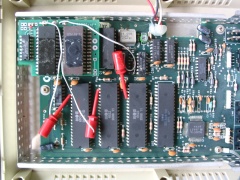
|
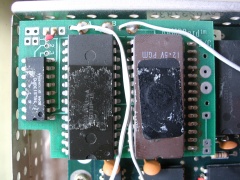
|
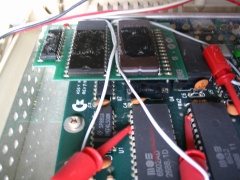
|
Here is a PDF of the instructions for this unit. They've been restored from scans of my originals by Wolfgang Moser ("Womo"), who has an excellent web page covering this piece in exhaustive detail (even including reverse-engineered schematics).
And here is a D64 image of the utility
disk that came with.
These are serial (RS-232) cards that were designed by Jim Brain. The Link-232 replicates the functionality of the CMD SwiftLink/Turbo232 cartridges (up to 38400 bps), while the EZ-232 is a user-port solution that can reach a maximum of 9600 bps (up9600-compatible). Here is a PDF of the hardcopy instructions and schematics I received when I bought one each of Dopple's boards at the C=4 Expo in 2007. He's not making them anymore, but you can get them from Dan Mackey.
When I posted the login screenshot on the right to Twitter, someone asked how I did it. It's really quite simple and I don't think it should depend too much on which serial card you use.
/lib/systemd/system/serial-getty@.service /etc/systemd/system/serial-getty@ttyS0.serviceExecStart line
to: --keep-baud 9600,4800,2400systemctl
daemon-reload, then start the getty with systemctl
start serial-getty@ttyS0./dev/ttyUSB0.Then all you have to do is start a terminal on the '64 (I
used the term program
from ACE
and a Link232). Make sure to connect to the Linux box using a
null-modem cable, and you may have to force hardware flow
control:
stty -F /dev/ttyUSB0 9600 -crtscts
Just hit Return and the login prompt should magically appear.
The TurboMaster (made by Schnedler Systems) provides a 65C02 processor to let the machine run at 4 MHz. (The ROM1 / ROM2 switch selects one of two patched ROMs: the "standard" ROM or a modified JiffyDOS 5.0 ROM.) Here's a PDF scan of the manual. It and the REU beneath it in the picture below are plugged into one of the rarest of Commodore devices, the Master Adapter. This was a device meant to allow the TurboMaster and a geoRAM or REU (RAM Expansion Unit) to coexist when running GEOS. Although beset by problems that resulted in spectacular operating system crashes, the device was eventually made to work by Paul Bosacki, who wrote the GEOS driver. If you want to hear the gory details of the Master Adapter's development just as we did on the Schnedler support forum on Q-Link, I've collected the ones I saved and converted them to ASCII. Here they are: the infamous Master Adapter messages. Here's a scan of the letter sent with the Master Adapter when it was first shipped, and here's the "Master Adapter Supplement", a ten-page document with hand-drawn diagrams explaining how to install the Master Adapter with an REU or a geoRAM. The utility disk containing GEOS drivers was updated on 1992-02-18 when the REU bugs were fixed, and this is the letter that was sent with it. At that point, the source code for the driver was included, and the saga reached its end...
...except that like everything else Commodore, it's been reverse-engineered and reproduced, and as I write this, apparently you can get one of these legendary devices here.
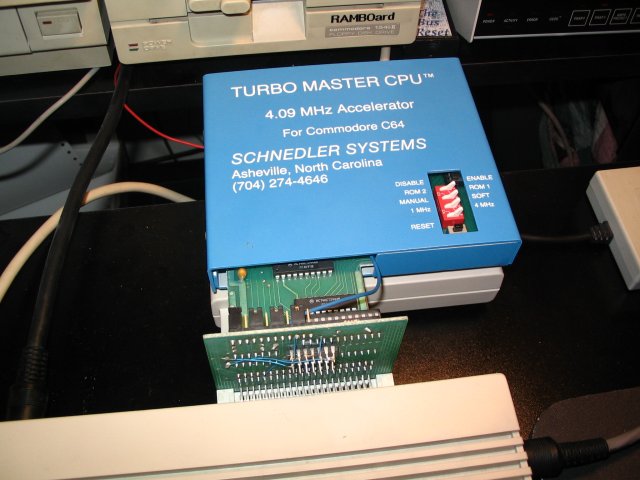
|
Wes Wiese sent pictures of his Master Adapter (see below), which has a different board layout. Click for larger images. | |
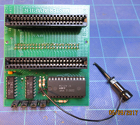
|
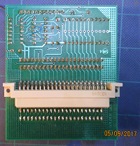
|
|

|

|
|

|
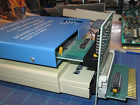
|
|
I saw one of these sticking out of Leif Bloomquist's machine at SWRAP 2004, and I knew I had to have one; the design is straight out of first-generation Star Trek! The text below comes from Cardco's advertisements of the mid-80s. DLH has scanned the docs; the diagram with the switch settings is on page 8. The CSM Program Protection Manual (vol. II) explains how to use the CB/5 and its toggle switches to make cartridge dumps (starting on page 161).
The CARDBOARD/5 (CB/5) is an enclosed five slot, fully switch selectable, expansion interface for the Commodore 64. The quality product allows the user to switch select any cartridge slot or combination of cartridge slots. There are twenty-two color coded light emitting diodes to give the status indication. Each slot has for LEDs and two toggle switches for indication and control. The two amber LEDs indicate the status (or or off) that the cartridge in that slot is requesting on the EXROM and GAMEROM lines. If the user wishes to honor this request, then one of the toggle switches must be turned on. This will light the green LED showing that the request is being honored. The two master status amber LEDs at the rear of the board will show the cumulative status on all slots selected. The second toggle switch at each slot enables power to the cartridge and the fourth (red) LED indicates power on condition. This allows the user supply power to a cartridge without allowing to auto-start or otherwise affect other operations. Additionally, there are two master toggle switches that allow the user to manually override any situation and set the lines as desired. The CARDBOARD/5 is fully fused and a reset button is provided.
Some of the feature of the CARDBOARD/5 are:
The Indus GT was made for Atari, Apple, and Commodore computers. Their over-the-top advertising proclaimed "What you get if you cross a Commodore 64 with a Ferrari... Most of all, you get luxury. From the sleek lines of its soundproofed chassis to the responsive AccuTouch™ controls at the Indus CommandPost™. From the LED display that keeps you in control of your Commodore to the air-piston operated dust cover that protects your disks and drive..." Flashy ad copy aside, the drive (which was advertised as 400% faster than Commodore's) is both beautiful and functional. Some of its more interesting features include:
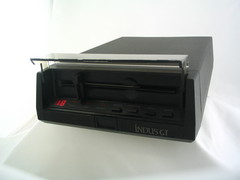
Front view showing LED display. |
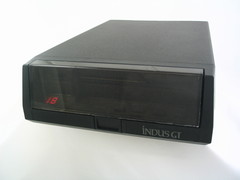
With the "built-in smoked plexiglass dust cover" closed. |
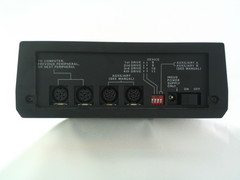
Rear view. The auxiliary ports were not implemented. |
A word about the aux ports: the manual (page 4) says "The two 8 position DIN jacks located at the back of the drive labeled: 'AUXILIARY (see manual)' have been been reserved for future use." However, I recently received an interesting email about them:
They are connected and could be controlled from the VIA 6522. At least this is what I found in my Indus.
Aux: 1 7 PA1 PA7 2 8 6 PA2 PA0 PA6 3 5 PA3 PA5 4 PA4Both the AUX ports are connected in parallel. There is 74LS245 buffer between VIA and the AUX connector, controlled by CB2 which is connected to 245's DIR (pin 1) and CA2 which goes to !G (pin 19).
Does anybody know if there was any software that used these ports?
If so, please email me:
cenbe at protonmail dot com.
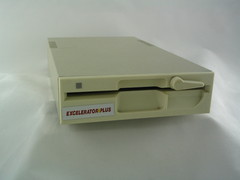
|
The Excelerator Plus is a very compatible drive in a small form factor, although it's surprisingly heavy. This one has been kitted out with JiffyDOS (there's a toggle switch on the back). Joe Palumbo (JPPBM) still sells these. |
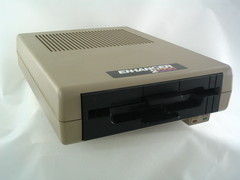
|
The Enhancer 2000 is a nice drive, but not entirely compatible (fast loaders tend to fail). You can see its circuit board and power supply on the right. Here's the owner's manual; there's some information on the software internals starting on page 30. |
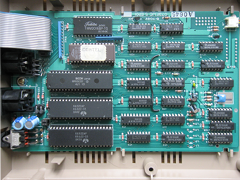
|
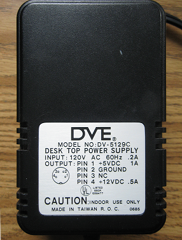
|